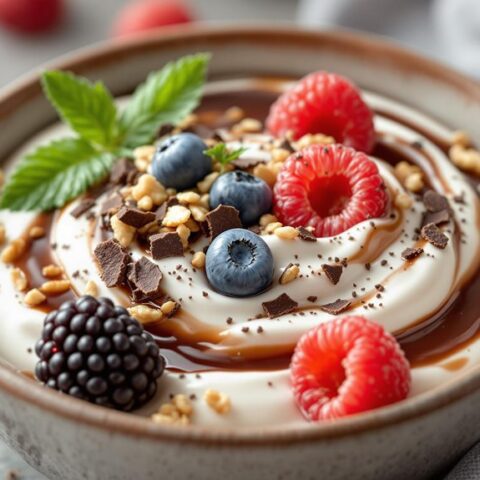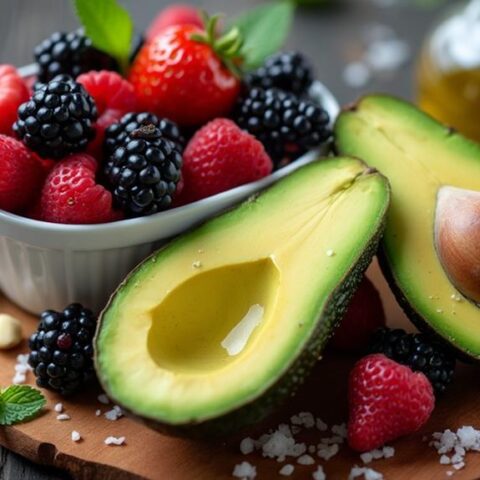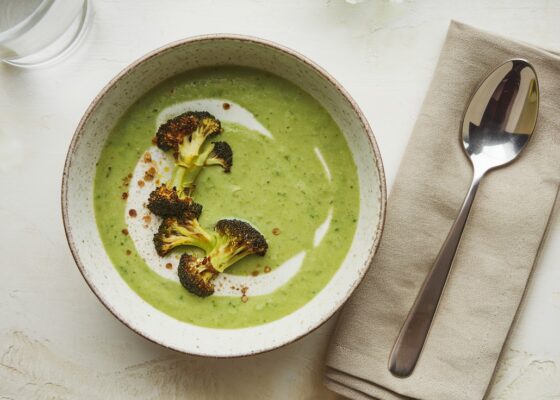
Tapioca is definitively not a low-carb food, containing 90 grams of net carbohydrates per 100 grams, with a quarter-cup serving delivering 27 grams of net carbs. Its glycemic index of 70 indicates rapid blood sugar spikes, making it unsuitable for low-carb or ketogenic diets. While tapioca contains small amounts of resistant starch, this benefit doesn't offset its high carbohydrate content. Alternative flours like almond or coconut offer considerably lower carb options, with numerous factors worth exploring.
Key Takeaways
- Tapioca contains 90 grams of net carbs per 100 grams, making it extremely high in carbohydrates compared to low-carb alternatives.
- A quarter-cup serving of tapioca flour contains 27 grams of net carbs, exceeding most daily carb limits for low-carb diets.
- Tapioca lacks dietary fiber and has a high glycemic index of 70, causing rapid blood sugar spikes.
- Alternative flours like almond (3g net carbs/quarter cup) and coconut (6g net carbs/28g) provide significantly lower-carb options.
- Healthcare experts advise against tapioca for low-carb diets as it disrupts ketosis and impedes weight management goals.
The Science Behind Tapioca and Carbohydrates
When examining the carbohydrate content of tapioca, scientific analysis reveals its significant impact on dietary choices. The cassava-derived ingredient contains approximately 90 grams of net carbs per 100 grams of flour, making it a particularly carbohydrate-dense food source.
A quarter-cup serving delivers around 27 grams of net carbs, which substantially affects blood sugar levels in the body.
Research indicates that tapioca's high glycemic index of 70 triggers rapid increases in blood glucose, prompting considerable insulin responses. Unlike alternative flours that contain beneficial fiber, tapioca lacks the dietary fiber necessary to offset its carbohydrate load.
Even modified versions, such as resistant tapioca starch, demonstrate similar effects on blood sugar levels due to their digestible carbohydrate components, making them comparable to standard tapioca regarding metabolic impact.
Understanding Tapioca's Glycemic Impact
The glycemic impact of tapioca presents significant considerations for individuals managing their blood sugar levels or following specific dietary protocols. With a glycemic index of 70, tapioca can rapidly spike blood sugar levels, making it particularly challenging for those on a low-carb diet or managing diabetes. The presence of 27 net carbs per quarter-cup serving of tapioca flour demonstrates its substantial carbohydrate content, which can quickly disrupt ketosis and metabolic goals. Unlike foods rich in dietary fiber that help moderate glucose absorption, tapioca's lack of fiber content (0 grams per cup) means its starches are quickly converted to glucose in the digestive system. This rapid conversion, combined with high digestibility, can lead to pronounced insulin responses and blood sugar fluctuations. It is important for individuals following a ketogenic diet to be aware of foods like tapioca that can disrupt ketosis, as maintaining steady blood sugar levels is crucial for effective diabetes management.
Net Carbs in Different Types of Tapioca Products
Various tapioca products exhibit considerably high net carb content, making them challenging choices for individuals following carbohydrate-restricted eating plans.
Tapioca flour contains a substantial 90 grams of net carbs per 100 grams, while a quarter-cup serving alone provides 27 grams of net carbs, which can quickly deplete daily carbohydrate allowances on restrictive diets.
With its hefty 90g net carbs per 100g, tapioca flour can rapidly consume carb allowances for those watching their intake.
Tapioca pearls, popular in bubble tea beverages, similarly contribute significant amounts of carbohydrates and can cause notable blood sugar elevations.
For those seeking low-carb alternatives, ingredients like almond flour offer dramatically reduced carbohydrate content, with just 3 grams of net carbs per quarter-cup serving.
This stark difference makes almond flour and similar substitutes more suitable options for maintaining stable blood sugar levels while adhering to carbohydrate-conscious dietary approaches.
Comparing Tapioca to Other Common Starches
Comparing tapioca with other common starches reveals significant differences in carbohydrate content and glycemic impact. When examining tapioca flour alongside low-carb alternatives, its high carbohydrate content becomes evident, with 90 grams of net carbs per 100-gram serving. Several healthier alternatives offer better options for maintaining stable blood sugar levels:
- Almond flour contains only 3 grams of net carbs per quarter cup serving, making it an excellent low-carb choice.
- Coconut flour provides just 6 grams of net carbs per 28-gram serving while delivering beneficial fiber.
- Green banana flour, with its resistant starch properties, offers a lower glycemic impact than tapioca.
The Keto diet's unique macronutrient ratios and metabolic conditions set it apart from other low-carb diets, emphasizing the importance of choosing alternatives like almond or coconut flour for those seeking to maintain ketosis. These comparisons clearly demonstrate that tapioca flour, while versatile in cooking, is not suitable for those seeking low-carb options or blood sugar management.
The Role of Resistant Starch in Tapioca
Tapioca contains a small amount of resistant starch, a complex carbohydrate that resists digestion in the small intestine and functions similarly to dietary fiber.
The processing methods used in creating tapioca products can greatly affect its resistant starch content, with higher temperatures generally reducing the beneficial resistant starch levels.
While resistant starch in tapioca may contribute to improved gut health through fermentation by beneficial bacteria, its overall low resistant starch content and high glycemic impact make it a less ideal choice for those seeking considerable digestive health benefits.
Resistant Starch Types Explained
When exploring the complexities of resistant starch in tapioca, it's essential to understand the distinct types and their roles in digestion.
Despite tapioca's high carbohydrate content, which makes it challenging for those following a keto diet, its resistant starch properties can influence blood glucose levels differently than regular starches.
Scientists categorize resistant starch into three main types:
- Type 1: Found naturally in whole grains and seeds, providing structural resistance to digestion
- Type 2: Present in raw potatoes and green bananas, maintaining resistance until cooking
- Type 3: Formed through retrogradation when starchy foods like tapioca are cooked and cooled
Understanding these distinctions helps explain why tapioca's resistant starch benefits may be outweighed by its overall carbohydrate content, particularly for those monitoring their carbohydrate intake closely.
Processing Effects On Starch
Processing methods greatly alter the starch composition and digestibility of tapioca products, particularly in relation to resistant starch formation. When tapioca undergoes heat and moisture treatment, some of its regular starch converts to resistant starch, which can influence its glycemic index and digestibility patterns in the body.
While these processing effects on starch create beneficial resistant starch that may support gut health, the fundamental nature of tapioca remains high in carbohydrates.
The transformation of regular starch into resistant starch through processing does not markedly reduce the overall carbohydrate content. Despite the presence of resistant starch and its potential benefits for blood sugar regulation, tapioca products continue to deliver substantial amounts of digestible carbohydrates that can impact blood sugar levels and pose challenges for those following low-carb dietary protocols.
Gut Health Benefits Examined
Although tapioca's high carbohydrate content presents challenges for low-carb dieters, its resistant starch component offers significant benefits for digestive health. Research demonstrates that this unique form of starch functions as a prebiotic, supporting the growth of beneficial gut bacteria and enhancing overall digestive function.
The key benefits of tapioca's resistant starch include:
- Production of short-chain fatty acids through colonic fermentation, strengthening gut barrier function
- Potential improvement in blood sugar control and insulin sensitivity
- Reduction in inflammation through enhanced gut microbiome balance
For those following a low-carb lifestyle, it's important to explore alternative sources of resistant starch, such as green bananas or cooled potatoes, to maintain gut health benefits while managing carbohydrate intake effectively.
Metabolic Effects of Tapioca Consumption
Consuming tapioca triggers significant metabolic responses in the body due to its high carbohydrate content and glycemic properties.
With tapioca flour containing 90 grams of net carbs per 100 grams and a high glycemic index of 70, it rapidly raises blood sugar levels upon consumption, prompting substantial insulin release.
For individuals following a ketogenic diet, tapioca's carbohydrate content poses particular challenges, as it can disrupt the metabolic state of ketosis necessary for fat burning.
The rapid absorption of these carbohydrates, combined with minimal fiber content, often leads to quick energy spikes followed by crashes. This metabolic pattern can contribute to increased hunger, higher caloric intake, and potential weight gain over time.
Additionally, frequent consumption may impact long-term insulin sensitivity, potentially complicating blood sugar management.
Tapioca Alternatives for Low-Carb Diets
For those following a low-carb lifestyle, several flour alternatives offer better nutritional profiles than tapioca, including almond flour, coconut flour, and sunflower seed flour, which can be used in various baking applications. These substitutes not only provide lower carbohydrate content but also offer additional health benefits, such as increased fiber and healthy fats, making them excellent choices for keto-friendly recipes and sugar-free desserts. When thickening sauces or creating puddings, alternatives like chia seeds and flaxseed meal can effectively replace tapioca while maintaining the desired consistency and adding nutritional value. Nuts and seeds are rich in healthy fats, fiber, and essential nutrients, making them ideal for keto snacking.
Best Keto Flour Substitutes
When seeking alternatives to tapioca flour on a low-carb diet, several nutritious flour substitutes can effectively maintain ketosis while providing excellent baking results.
These keto-friendly options contain considerably fewer carbohydrates than tapioca flour while offering unique nutritional benefits.
- Almond flour leads the way as a versatile substitute, containing only 3 grams of net carbs per quarter cup compared to tapioca flour's 27 grams.
- Coconut flour provides excellent moisture retention and high fiber content, making it ideal for baked goods requiring structure.
- Flaxseed meal, sunflower seed flour, and pecan flour offer additional low-carb alternatives, with the added benefits of healthy fats, omega-3 fatty acids, and nut-free options for those with allergies.
Making Chia Seed Pudding
Beyond flour alternatives, chia seeds present an excellent low-carb substitute for traditional tapioca-based puddings.
While tapioca has a high carbohydrate content and minimal nutritional value, chia seeds offer just 2 grams of net carbs per ounce along with significant health benefits from fiber and omega-3 fatty acids.
Creating chia seed pudding is straightforward: combine 3 tablespoons of chia seeds with 1 cup of unsweetened almond or coconut milk, then refrigerate overnight.
The mixture transforms into a creamy pudding with a texture similar to tapioca. Enhance the flavor by incorporating vanilla extract, cocoa powder, or natural sweeteners like stevia.
For added variety and nutrition while maintaining low-carb principles, top the pudding with fresh berries or chopped nuts.
Low-Carb Thickeners That Work
Those following low-carb diets can effectively replace tapioca with several alternative thickening agents that maintain recipe consistency while minimizing carbohydrate intake.
These low-carb alternatives provide excellent thickening properties while keeping net carbs considerably lower than traditional options.
Several proven low-carb thickeners stand out for their versatility and effectiveness:
- Xanthan gum and guar gum offer negligible carbs per serving, making them ideal for sauces and gravies.
- Almond flour contains only 3 grams of net carbs per quarter cup, perfect for baking applications.
- Chia seeds and psyllium husk provide thickening power with just 1 gram of net carbs per tablespoon, while adding beneficial fiber.
Coconut flour serves as another excellent option, effectively absorbing moisture while maintaining a low carbohydrate profile in recipes.
Breaking Down Tapioca's Nutritional Profile
Understanding tapioca's nutritional composition reveals why it poses challenges for those following low-carb dietary protocols. With 90 grams of net carbs per 100 grams, tapioca flour's carb content greatly exceeds the limits of most low-carb diets. A single quarter-cup serving contains 27 grams of net carbs, making it particularly problematic for maintaining ketosis. Consuming high-carb foods like potatoes and sweet potatoes can disrupt ketosis, similar to the effects of tapioca. The health implications of consuming tapioca flour extend beyond its high carbohydrate content. With 440 calories per cup and minimal nutritional benefits, it lacks the protein, fiber, and healthy fats found in low-carb alternatives. Its high glycemic index of 70 can trigger rapid blood sugar spikes, potentially disrupting metabolic stability. For those seeking low-carb options, alternatives like almond or coconut flour offer better nutritional profiles and blood sugar management.
Research on Blood Sugar Response to Tapioca
Scientific research provides compelling evidence regarding tapioca's considerable impact on blood glucose levels, with studies consistently demonstrating its high glycemic load.
Health researchers have identified several key concerns about tapioca's carb content and its effects on blood sugar management:
- Tapioca's glycemic index of 70 triggers rapid blood sugar spikes, making it challenging for individuals monitoring their glucose levels.
- A quarter-cup serving contains 27 grams of net carbs, considerably impacting daily carb limits.
- Tapioca-derived isomalto-oligosaccharides demonstrate a pronounced effect on insulin response, potentially disrupting blood sugar stability.
For those on the keto diet, tapioca's high carb content can challenge maintaining ketosis, as its digestible components convert quickly to glucose, affecting metabolic health and potentially disrupting ketosis in those following ketogenic protocols.
Making Smart Choices With Tapioca Products
Understanding tapioca's high carbohydrate content, with 27 grams of net carbs per quarter cup, enables consumers to make informed decisions about its role in their low-carb lifestyle. Those following ketogenic or low-carb diets should consider alternatives like almond flour or coconut flour, which provide better nutritional profiles with fewer carbs and additional benefits such as protein and healthy fats. When shopping for tapioca products, careful label reading becomes essential, as some items marketed as low-carb may still greatly impact blood sugar levels and derail dietary goals. It's important to understand the distinction between ketoacidosis and ketosis to ensure safe dietary practices when considering carbohydrate sources.
Tapioca's Hidden Carb Content
The carbohydrate content lurking in tapioca products often surprises health-conscious consumers who might assume this grain-free ingredient aligns with their low-carb goals. A closer examination reveals notable hidden carbohydrate content that can impact dietary plans, especially for those following ketogenic lifestyles.
Consider these important facts about tapioca's carbohydrate profile:
- A quarter cup of tapioca flour contains 27 grams of net carbs, more than many people's entire daily carb allowance on keto.
- With 108 grams of carbohydrates per cup and no dietary fiber, tapioca flour causes rapid blood sugar elevation.
- Even products labeled "keto-friendly" may include tapioca fiber that can disrupt ketosis.
For those seeking low-carb alternatives, options like almond flour and coconut flour provide better choices with considerably lower carbohydrate content and additional nutritional benefits.
Keto-Friendly Tapioca Alternatives
When seeking to maintain ketosis while still enjoying familiar textures and tastes, numerous alternatives to traditional tapioca products offer viable solutions for low-carb dieters. Several keto-friendly alternatives provide superior nutritional benefits while keeping carbohydrate content minimal.
| Alternative | Net Carbs/¼ cup | Key Benefits |
|---|---|---|
| Almond Flour | 3g | High protein, healthy fats |
| Coconut Flour | 4g | High fiber, minerals |
| Chia Seeds | 1g | Omega-3s, fiber |
| Resistant Dextrin | 2g | Prebiotic properties |
These substitutes not only maintain the desired consistency in recipes but also offer additional nutritional advantages over tapioca flour. While resistant dextrin requires careful portioning, options like almond flour and chia seeds can be used more liberally in low-carb cooking applications, providing versatility without compromising ketosis.
Reading Product Labels Carefully
Making informed decisions about tapioca products begins with careful examination of product labels, particularly for those following low-carb dietary plans.
When evaluating the nutritional value of tapioca flour and similar products, consumers should focus on three critical aspects:
- Check the total carbohydrate content, noting that a quarter-cup of tapioca flour contains approximately 27 net carbs.
- Identify the specific type of tapioca fiber used, ensuring only soluble or Non-IMO varieties are present.
- Look for hidden sugars or additives that could increase the overall carb count.
For those seeking low-carb alternatives, comparing tapioca flour to options like almond flour, which contains just 3 grams of net carbs per quarter-cup, can help make more suitable choices.
Reading product labels carefully helps avoid misleading "keto-friendly" claims that may not align with dietary goals.
Myths and Facts About Tapioca's Carb Content
Popular misconceptions about tapioca's carbohydrate content have led many health-conscious individuals to believe it might fit into their low-carb lifestyle plans.
However, examining tapioca flour's nutritional profile reveals a stark reality: it contains approximately 90 grams of net carbs per 100-gram serving, making it unsuitable for low-carb diets.
Tapioca flour packs a hefty 90g of net carbs per 100g, making it a poor choice for carb-conscious eating plans.
The facts dispel common myths about this gluten-free ingredient.
While marketed as a health-conscious alternative, tapioca flour provides 27 grams of net carbs per quarter cup and lacks dietary fiber to moderate its impact on blood sugar.
With a glycemic index of 70, it can cause significant blood glucose spikes.
Those seeking low-carb alternatives should consider options like almond flour or coconut flour, which contain just 3 and 6 grams of net carbs per quarter cup, respectively.
Practical Ways to Fit Tapioca in a Low-Carb Lifestyle
Despite tapioca's high carbohydrate content, health-conscious individuals can still incorporate this versatile ingredient into their low-carb meal plans through careful portioning and strategic combinations.
For those committed to maintaining their dietary goals while enjoying tapioca's unique properties, consider these practical approaches:
- Mix tapioca flour with low-carb alternatives like almond or coconut flour to reduce the overall carbohydrate content in recipes.
- Use minimal amounts of tapioca as a thickening agent, focusing on its functional properties rather than as a main ingredient.
- Consider resistant dextrin as a substitute when possible, as it offers similar culinary benefits with a lower glycemic impact.
Remember to choose keto-friendly sweeteners to pair with tapioca dishes, ensuring the entire meal aligns with your low-carb goals.
Monitoring portion sizes remains essential when incorporating tapioca into a low-carb lifestyle, ensuring it complements rather than compromises nutritional objectives.
Expert Recommendations for Tapioca Consumption
Healthcare professionals and nutrition experts consistently advise against regular tapioca consumption for individuals following low-carb dietary protocols, given its substantial carbohydrate content and high glycemic impact.
Tapioca's high carbohydrate profile makes it incompatible with low-carb diets, requiring careful consideration from those monitoring their carbohydrate intake.
They emphasize that tapioca flour, containing approximately 90 grams of net carbs per 100-gram serving, can considerably disrupt ketosis and impede weight management goals.
For those seeking to maintain a low-carb or ketogenic diet, experts recommend shifting to nutritionally superior alternatives. Almond flour and coconut flour stand out as preferred choices, offering considerably lower carbohydrate content while providing additional nutritional benefits.
When reviewing nutritional information, health practitioners particularly stress the importance of understanding that even products marketed as modified tapioca ingredients may still impact blood sugar levels, making them unsuitable for strict carbohydrate-restricted eating plans.
A low carbohydrate intake prompts the body to enter a state of ketosis, where fat is used for energy instead of sugar.
Frequently Asked Questions
Is Tapioca a Low Carb Diet?
Tapioca's nutritional value shows high carbohydrate content, making it unsuitable for low-carb diets. Health benefits aside, those seeking alternatives should consider almond flour, which offers better macronutrient ratios for low-carb recipes.
Does Tapioca Spike Insulin?
Tapioca causes significant insulin spikes due to its rapid digestion process. Its high glycemic index of 70 raises glucose levels quickly, leading to pronounced insulin response and potential health effects on blood sugar management.
Can I Eat Tapioca for Weight Loss?
Tapioca's high carbohydrate content makes it challenging for weight loss strategies. While offering some benefits, healthier alternatives with lower carb content are recommended. If consumed, strict portion control becomes essential for managing calories.
Is Tapioca a Good Source of Carbs?
Tapioca provides abundant carbohydrates but lacks significant nutritional value beyond energy. While versatile in cooking methods, its high glycemic index and minimal fiber content make it less ideal for balanced dietary uses.
Conclusion
Tapioca's carbohydrate content makes it challenging to classify as strictly low-carb, with 100 grams containing approximately 86 grams of carbs. However, portion size and preparation method considerably impact its place in a low-carb diet. While those following strict ketogenic diets should avoid tapioca, individuals on moderate low-carb plans can incorporate small amounts mindfully. Understanding serving sizes and choosing appropriate tapioca products allows for balanced dietary decisions.










No Comments